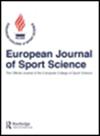Short-term high-Intensity interval training increases systemic brain-derived neurotrophic factor (BDNF) in healthy women
IF 3
3区 医学
Q2 SPORT SCIENCES
引用次数: 19
Abstract
Abstract Background: Brain-derived neurotrophic factor (BDNF) increases neuronal viability and cognitive function, peripheral lipid metabolism and skeletal muscle repair. The primary purpose of this study was to determine the effect of short-term high-intensity interval training (HIIT) on serum BDNF concentrations in healthy young women. Methods: Seventeen women (age:22 ± 1 years); body mass index (BMI:24.2 ± 2.2 kg/m²), body fat percentage (% fat:25.8 ± 4.7) participated in the study. Participants were randomly assigned to a control (n = 8) or HIIT group (n = 9). All participants performed a graded exercise test (GXT) on an electronically-braked cycle ergometer to determine maximal aerobic power (MAP, Watts). HIIT was performed three days per week for four weeks. Each HIIT session consisted of three to five cycling bouts of 30 s each at 80% MAP, followed by four-minutes of recovery at 40% MAP. Forty-eight hours after the last bout of exercise, both groups performed a follow-up GXT. Non-fasting blood samples were collected before and immediately after each GXT. Mixed factorial (2 groups x 4 measures, and 2 groups x 2 measures) ANOVA was used to assess BDNF concentrations, performance and anthropometric variables. Results: Serum BDNF concentrations in the HIIT group (21.9 ± 1.3 ng/mL) increased compared to control (19.2 ± 2.8 ng/mL) (∼12%, P < 0.05) following HIIT. In contrast, circulating BDNF concentrations were reduced following the GXT (P < 0.05). The MAP and % Fat did not change with HIIT. Conclusions: Twelve sessions of HIIT increases circulating BDNF concentrations in healthy young women despite no change in physical performance or % fat.短期高强度间歇训练增加健康女性全身脑源性神经营养因子(BDNF)
背景:脑源性神经营养因子(BDNF)增加神经元活力和认知功能,外周脂质代谢和骨骼肌修复。本研究的主要目的是确定短期高强度间歇训练(HIIT)对健康年轻女性血清BDNF浓度的影响。方法:17例女性(年龄22±1岁);体重指数(BMI:24.2±2.2 kg/m²)、体脂率(% fat:25.8±4.7)参与研究。参与者被随机分配到对照组(n = 8)或HIIT组(n = 9)。所有参与者都在电子制动自行车测力仪上进行了分级运动测试(GXT),以确定最大有氧能量(MAP, Watts)。HIIT每周进行3天,持续4周。每次HIIT训练包括3 - 5次骑行,每次30秒,80% MAP,然后是4分钟的40% MAP恢复。最后一次运动48小时后,两组都进行了GXT随访。在每次GXT之前和之后立即采集非空腹血液样本。采用混合因子(2组x 4个测量值,2组x 2个测量值)方差分析评估BDNF浓度、表现和人体测量变量。结果:HIIT组血清BDNF浓度(21.9±1.3 ng/mL)高于对照组(19.2±2.8 ng/mL)(约12%,P < 0.05)。相比之下,GXT后循环BDNF浓度降低(P < 0.05)。MAP和% Fat没有随HIIT改变。结论:12次的HIIT增加了健康年轻女性循环BDNF浓度,尽管身体表现或脂肪百分比没有变化。
本文章由计算机程序翻译,如有差异,请以英文原文为准。
求助全文
约1分钟内获得全文
求助全文
来源期刊
CiteScore
6.60
自引率
3.10%
发文量
153
审稿时长
6-12 weeks
期刊介绍:
The European Journal of Sport Science (EJSS) is the official Medline- and Thomson Reuters-listed journal of the European College of Sport Science. The editorial policy of the Journal pursues the multi-disciplinary aims of the College: to promote the highest standards of scientific study and scholarship in respect of the following fields: (a) Applied Sport Sciences; (b) Biomechanics and Motor Control; c) Physiology and Nutrition; (d) Psychology, Social Sciences and Humanities and (e) Sports and Exercise Medicine and Health.

 求助内容:
求助内容: 应助结果提醒方式:
应助结果提醒方式:


